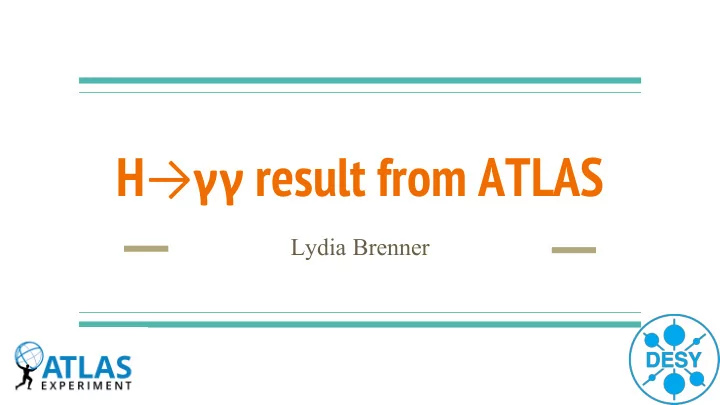

H → γγ result from ATLAS Lydia Brenner
Introduction ATLAS I will try to compare some details to the latest CMS paper
Introduction H →γγ summer result ATLAS-CONF-2018-028, 79.8/fb of data, √ s=13 TeV
So what did ATLAS publish? - Production-mode cross-sections: ggF, VBF, VH, top. - Stage1 Simplified Template Cross-Sections (STXS) with strong merging. Fiducial cross-section measurement. - Differential cross-sections: pT( γγ ), |y( γγ )|, pT(j1), N(b-jets). Reduced statistical uncertainties and additional differential measurements compared to arXiv:1802.04146 using 36.1/fb of data. The 36/fb paper has comparable differential distributions to the latest CMS paper
Analysis strategy
Purity The purity of γγ events in the diphoton fiducial region CMS uses a BDT for Photon ID, while ATLAS uses a cut-base method
Event generators used
STXS bins - Stage-0 simplified template cross section regions are indicated with an adjacent square. - stage-1 regions are denoted with a circle. - Some stage-1 regions are omitted in cases where the data set lacks the sensitivity to resolve them
Kinematic regions in STXS stage-1 Two regions are indicated as BSM-like and are summed
Reconstruction categories Each event is assigned to the first category whose requirements are satisfied, using the descending order given in the table Horizontal lines based on the definitions of the stage-0 simplified template cross sections
Fitted signal parametrisation Best and Worst mass resolutions Using slightly different diphoton mass ranges; ATLAS: 105-160 GeV CMS: 100-180 GeV
Signal composition Jet p T cut; ATLAS: 25/30GeV central/Forward CMS: 30GeV everywhere b-tagging working point; ATLAS: 70% ● 380x light quark rejection CMS: 55% ● 1000x light quark rejection Leptons; ATLAS: 15 GeV + loose isolation CMS: 20 GeV
Particle level object definition
Diphoton invariant mass spectrum VH ■ Signal Modelling; ■ ATLAS: DSCB+Gaussian ggF ■ CMS: Sum of 5 Gaussians VBF top
Diphoton invariant mass spectrum Background model from Sherpa with spurious signal tests CMS includes background model directly in Likelihood model
Production mode correlations Small correlations between the different production modes
STXS cross-sections
STXS correlations Mostly small correlations
Breakdown of the uncertainties Systematic uncertainties including PER, Photon ID and spurious signal CMS does not include additional background model uncertainties beyond terms in Likelihood Statistical component dominates in differential regions
Intermezzo: Unfolding Idea Model detector response Theory Data Modelling detector response versus unfolding Unfold You want to know the underlying physics, not only if it matches with predictions
Intermezzo: Unfolding mathematically Model detector response Theory Data The forward model can be described by a Unfold smoothing matrix - Limited detector resolution throws information away In reverse mode (unfolding) matrix has to Comparison with Maximum Likelihood Estimate recreate sharp points MLE is unbiased, but has large variance - Regularisation used to enforce a degree of Unfolding deliberately adds a small bias to smoothness on the reconstructed distribution produce a solution with a much smaller variance Note: Normally a pseudo inverse of the matrix is used based on a maximum Likelihood fit
� � � � � Intermezzo: Choosing Unfolding Method 𝑐 $ < 𝜏 '()(,$ -./. 𝜏 $,'()( |𝑐 $ | For each bin 1)() < 1 𝜏 $,'()( 𝜏 $,'()( - Biases (b i ) should be small compared to statistical uncertainties - Unfolding should not greatly alter the statistical uncertainty For each distribution there are different figures of merit - Total statistical uncertainty 45$. 𝜏 '()(,$ 6 Σ $ - Sum of biases (b i ) 45$. 𝑐 $ Σ $ 45$. |𝑐 $ | Σ $ - Absolute sum of biases (b i ) 45$. |𝑐 $ | Σ $ 𝐷𝑝𝑤 $,; (𝑡𝑢𝑏𝑢) - Total stat. error, including correlations 𝐷𝑝𝑤 $,; (𝑡𝑢𝑏𝑢) - Bias divided by total stat error '()( (𝑛𝑓𝑢ℎ𝑝𝑒) 𝐷𝑝𝑤 $,; - Ratio of total stat error of the method w.r.t. bin-by-bin | | '()( (𝑐𝑐𝑐) 𝜓 6 = 𝜈 𝐷𝑝𝑤 $,; LM Shape via 𝜓2 ⃗ 5$)' ) N - ⃗ HI − 𝜈 ⃗ 5$)' 𝐷𝑝𝑤 H()(K5 (𝜈 ⃗ HI − 𝜈
Unfolding Bin-by-bin method , c is the correction factor - Derived from simulations - Inclusive diphoton fiducial region: c = 0.73 ± 0.04 - Differential cross-sections: c ∼ 0.7 − 0.8 (except a couple of bins) - Largest impact: photon identification efficiencies Reasons for choosing bin-by-bin - Introduces minimal bias - Performance acceptable given statistical limits of this measurement CMS: Unfolding matrices directly in the Likelihood with no regularisation (wide enough bins)
γγ p T 𝑄 𝜓 6 = 31% Default MC: Powheg NNLOPS, normalization: Additionally: NNLOjet+SCETL N3LO(QCD) and NNLO+N3LL resummation NLO(EW)
|y γγ | 𝑄 𝜓 6 = 56% Default MC: Powheg NNLOPS, normalization: N3LO(QCD) and NLO(EW) Additionally compared to SCETlib+MCFM8
p T j1 𝑄 𝜓 6 = 88% Default MC: Powheg NNLOPS, normalization: Additionally compared to NNLOJET and N3LO(QCD) and SCETlib(STWZ) NLO(EW)
Higgs with Heavy flavour Measurement of the number of b-jets - Higgs with heavy flavour poorly constrained theoretically for ttH and hh - Veto on electrons and muons to reduce ttH contribution - H+HF best probed for N b-jet =1 - Associated HF production: QCD splitting
N b-jet 𝑄 𝜓 6 = 84% Default MC: Powheg NNLOPS, normalization: N3LO(QCD) and NLO(EW)
Conclusions Statistical improvement from 36/fb to 80/fb: 16% → 10% - Will improve further with full Run 2 dataset Excellent agreement with the SM in all regions - Will try to reduce systematics further for full Run 2 dataset Bin-by-bin unfolding - Will need to update unfolding method for full Run 2 dataset Start made on Higgs with heavy flavour - Will created fiducial region for full Run 2 dataset using continuous b-tagging method
Back-up
Signal efficiencies
Higgs composition
Effective signal mass resolution
Expected correlations between bins
Recommend
More recommend